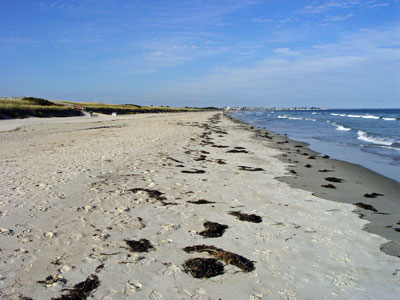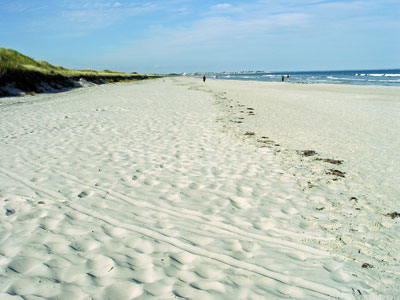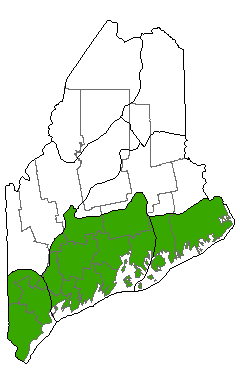DACF Home → Bureaus & Programs → Maine Natural Areas Program → Communities, Plants, and Animals → Natural Community Fact Sheets → Coastal Beach
Printer Friendly Fact Sheet - 670 KB pdf (Get a free copy of Adobe Acrobat Reader)
Coastal Beach
Scientific Name: Beach Strand; State Rank: S4

- Community Description
- Soil and Site Characteristics
- Diagnostics
- Similar Types
- Conservation, Wildlife and Management Considerations
- Distribution
- Characteristic Plants
- Associated Rare Plants
- Associated Rare Animals
- Examples on Conservation Lands You Can Visit
Community Description: These types consist of sparsely vegetated upper beaches, where plants are adapted to the effects of salt spray, coarse sand and cobble, and drying winds. These include annuals such as sea-beach sandwort, sea-kale, beach-pea, and others. On Downeast gravel/cobble beaches, oysterleaf may be characteristic. This linear community is usually bordered landward by either sand dunes or upland forest vegetation. Back to top.
Soil and Site Characteristics: Beach strands occur above the usual high tide line on sand or gravel coastal beaches. They are occasionally flooded at very high tides. Back to top.

Diagnostics: Located just above the high tide line, beach strands are distinguished by the presence of beach-pea and sea-kale; forbs are more abundant than grasses. Back to top.
Similar Types: Dune Grasslands may be adjacent, and species overlap between the two; but dune grasslands have a higher vegetative cover and are strongly dominated by graminoids rather than by forbs. Back to top.
Conservation, Wildlife and Management Considerations: This narrow band of vegetation usually lies landward of the most heavily walked portions of beaches and has likely been reduced or eliminated at popular beaches. Many examples exist on several public lands and private conservation lands. Raking seaweed from the beach to the dune fronts can affect the composition of this community. The prospect of sea level rise may also put these systems at greater risk.
Upper beaches and adjacent dune grasslands are critical breeding habitat for two species of rare shorebirds: least terns and piping plovers. Nesting habitat for these birds has been reduced by human use of beaches and the known nesting sites in Maine are carefully monitored. Beach Strand communities also provide breeding habitat for common terns, though this species also breeds on inland lakeshore beaches. Rare roseate terns breed on sandy or gravelly beaches, especially those that occur on offshore islands. American oystercatchers are extremely rare breeders on coastal beaches of southern Maine. Beaches are also major roosting sites for migratory shorebirds. Back to top.
Distribution: Coastwide, extending both south along the Atlantic seaboard and eastward into the Canadian Maritimes (Eastern Broadleaf Forest and Laurentian Mixed Forest Provinces). Landscape Pattern: Small Patch, linear. Back to top.


Characteristic Plants: These plants are frequently found in this community type. Those with an asterisk are often diagnostic of this community.
- Herb
- American shore-grass
- Beach-pea
- Common saltwort
- Sea milkwort
- Sea-beach sandwort
- Sea-kale
- Spearscale
- White sea-blite
- Witch grass
- American oystercatcher
- Common tern
- Least tern
- Piping plover
- Roseate tern
Examples on Conservation Lands You Can Visit
| Example | County |
|---|---|
| Howard's Cove, Machiasport | Washington Co. |
| Petit Manan National Wildlife Refuge | Hancock Co. |
| Popham Beach State Park | Sagadahoc Co. |
| Reid State Park | Sagadahoc Co. |
| Roque Bluffs State Park | Washington Co. |
| Scarborough Beach State Park | Cumberland Co. |
| Seawall Beach, Morse Mountain Preserve | Sagadahoc Co. |